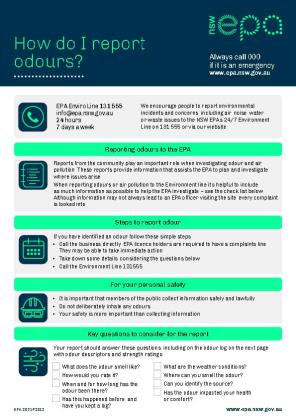Community guide for reporting odours
- Reports from the community can play an important role in investigating odour and air-pollution incidents.
- The EPA needs a certain level of detail from the community to be able to investigate effectively.
- If you smell something and you know where it is coming from, call the licensed site directly. The manager may be able to take immediate action. Licence holders are required to have a complaints line. You should also report to the EPA Environment Line.
- It is important that community members only collect information if it is safe and lawful to do so.
- For more information, see the fact sheet How do I report odours?
Guiding industry in best management practices
The EPA’s policy framework for managing odour is the Technical framework - assessment and management of odour from stationary sources in NSW. The framework:
- guides industry, consent authorities, planners, environmental regulators and odour specialists in dealing with odour issues
- recommends ongoing environmental improvement and best management practices to prevent or minimise odour
- promotes sustainable land use planning and management to minimise odours and avoid associated conflicts, while recognising the changing needs of industry and society
The framework is accompanied by Technical notes: Assessment and management of odour from stationary sources in NSW (PDF 255KB), which provides detailed odour assessment procedures.
Investigating odour complaints
Field odour surveys are a useful tool when investigating odour related complaints and can be used to gather information about the nature and extent of odour from existing activities.
This guideline is intended as a publicly available resource to be used for ensuring that a consistent approach is applied when investigating odour-related complaints.
The Guide to conducting field odour surveys (PDF 376KB) can be used to ensure odour surveys are conducted in a repeatable and objective manner. The Guide provides direction and methods that will help to:
- confirm the source of odours
- assist to confirm the effectiveness of odour controls or strategies to mitigate odour
- prompt targeted regulatory oversight by an authority.
Calculator for meat chicken (broiler) farm developments
In consultation with the then Department of Trade and Investment, Regional Infrastructure and Services and the then Department of Planning and Infrastructure, the EPA developed an odour assessment calculator in Excel format (XLS 38KB) to assist poultry farmers and their consultants to:
- plan for chicken broiler farm developments
- inform site purchase decisions.
The calculator uses the formulae defined in section 5 of the technical notes to calculate required setback distances for a particular site using level 1 assessment specified in the technical framework (PDF 260KB). Setback distances calculated as a result of incorrect inputs may not be approved by agencies managing the development approvals process.
If a site cannot accommodate the calculated setback distance, a more complex level 2 or 3 assessment may be required.
The calculator makes it easier for proponents of chicken broiler farms to use the level 1 method to assess sites before purchase rather than attempting to develop farms at sites after the development application process has begun.
More information on selecting appropriate sites for meat poultry (broiler) farm developments is provided in the Department of Primary Industry’s fact sheet.


